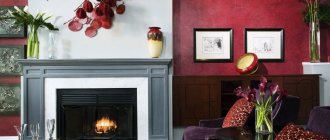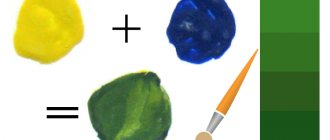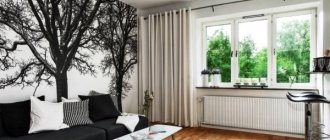28.02.2021
,
The complex lilac color evokes associations with royal luxury, power and ambition. Until the 19th century, the production of a rare dye in nature was very expensive. Therefore, only rich people could afford lilac interiors. The color also gained its reputation as a “royal” color due to the love of the legendary kings for the delicate shade of purple. And this is not surprising. The soft lilac tone is universal in its characteristics. It can be dramatic, moody, bright, cheerful, energizing in the morning and calming in the evening. Today, lilac color in the interior is at the peak of popularity. This is the perfect shade for experimenting with traditional styles.
Features of color and influence on the psyche
Lilac means a bleached purple color, it belongs to the cool spectrum of tones and is well suited for rooms with windows facing east and south. Adding more red paint warms up the hue, so it can be used even in northern rooms.
The soft lilac color fits harmoniously into many interior styles: it is relevant in both classic, modern, and vintage styles. The shade brings its charm to any room, giving a person a powerful energy boost. In psychology, lilac has an important meaning: it symbolizes sensuality, mystery, creativity and romanticism.
Color has a positive effect on a person: if used within reasonable limits, it will help to calm down, get rid of unnecessary worries, and reduce hyperactivity. At the same time, when in excess, lilac can provoke fear and depression, because it is formed by two strong and rather aggressive tones opposite to each other. It is also believed that a too bright lilac palette can cause mistrust and secrecy when communicating.
Calming bedroom
Different intensities of lilac can create a very cozy atmosphere for the bedroom. Purple will be too stimulating, but adding pastel lilac, you can get relaxation. It is enough to decorate the wallpaper with wood panels, and a romantic atmosphere has already been created for the bedroom. If you do not use “screaming” shades, then it will look very gentle and light. Beige and wood tones are ideal for curtains, and for walls you should choose wallpaper in a gray-lilac style.
Delicate lilac color in the bedroom is calming
Bedroom with lilac walls
A successful combination of lilac shades in the bedroom
Bedroom with lilac accent
The lilac color in the interior is ideal for a children's bedroom. It has many bright variations and at the same time does not excite the child’s psyche. Soft lilac is best suited for a girl’s bedroom, and dark purple will be appreciated by little boys. The children's world is filled with fantasies, so by adding bright green and yellow, the child will be charged with positivity. In a nursery, it is better to avoid using gray in wall decoration - it will be dark and uncomfortable for the baby.
Beautiful bedroom for a girl in lilac tones
Rich lilac and beige colors in the bedroom
Lilac curtains and bed in the bedroom
Bedroom with bright lilac curtains
Dark lilac color in the interior of the bedroom
Lilac bed in the interior
Brown bedroom with bright lilac bedding
Bedroom for young girls and teenagers
Shades of lilac
In nature, shades of lilac in pure form are rarely found - mainly in the flower petals of lilac and some other plants. But even there are more than forty varieties of lilac, and there are many more artificially created lilac tones. Using shade tables, designers determine the tone that is suitable for a particular situation, and then select companion colors to match it.
The most popular colors in interior design are:
- classic lilac;
- gray-lilac;
- soft lilac;
- soft violet;
- bluish-lilac;
- pale lilac;
- lavender;
- blue-lilac;
- blurry purple;
- beige-lilac;
- lilac pearlescent;
- cyclamen;
- silver-lilac;
- amethyst, etc.
All differences in tones are due to the proportion of blue and red, as well as the amount of white and the presence of additives of other colors. For example, a pastel white-lilac color contains a lot of white, while blue-lilac is easier to call blue with a lilac tint: it is so dark. There is a lot of pink in the violet color; dusty lilac has a muted, blurry tone, which is why it is very popular in design.
Children's
The lilac design of a nursery is an option that is suitable not only for a girl, but also for a boy, because according to psychologists, it will have a positive effect on the still fragile psyche and nervous system. Using light lilac tones you can visually expand a small room.
If the walls in the nursery are pale, focus on the furniture. A bright bed or wardrobe will look very expressive.
Combinations with other colors
Lilac can be combined with various shades. It is not recommended to use this tone to create a monochrome interior; it looks better surrounded by contrasting tones.
Lilac with white
Shades of lilac go well with white – the freshest, neutral color. The finished duet will look tender and romantic. Warm lilac shades go well with creamy, milky tones, while cool colors (with more blue than red) are ideal with crystal white tones. If light lilac shades are the background for the walls, then white can be used as the color of the ceiling and various accents - paintings, figurines, textiles.
Lilac with gray
This combination is considered very stylish, but rather cold. It is better to use gray color as a background, which sets off the lilac details, while making the interior more complex and multifaceted. This range looks great with laminate flooring, parquet with a gray tint (for example, smoky oak), as well as with granite or grayish marble.
Lilac also goes well with shades of metal, especially silver. Silver curtains will give the room a sophisticated, glamorous look, and white furniture on a lilac background will complete the stylish look of the room.
Lilac with green
Green in tandem with lilac is considered a classic option when decorating interiors in the Provence style. This range brings to mind flowering plants: lavender, irises, lilacs, violets. It is only important to choose the right shades. Green-brown or olive color looks beautiful with lavender, and turquoise with dark lilac diluted with beige and white tones. The palette of pistachio or mint is suitable for pastel, bleached versions of lilac. One or two tones should be made thick, but be sure to complement them with blurry details.
Lilac with yellow
Yellow paired with lilac is a fashionable design option for interior design. In some color combinations the sunny color is lost, but here it reveals itself in full force and gives positive energy. It is best to combine pink-lilac tones with mustard yellow (warm palette) or bluish-lilac with lemon (cool palette).
Lilac with beige
Milky-creamy, beige, caramel colors combine perfectly with lilac flowers. Muted, light tones will become the basis for dark lilac shades, forming a stylish interior for a bedroom, living room, or children's room. Beige tones create a soft, cozy atmosphere in which a person will feel calm and comfortable.
Purple-lilac interior
Lilac and violet are in the same palette, so you need to combine them carefully. If there is an overabundance, the room will look intrusive and depressing. It is better to use up to 70-80% pastel lilac tones, adding bright accents of dark purple in the form of throws on the sofa, chairs, armchairs, rugs, photo frames, and other accessories.
Pink and lilac design
This tandem is considered girlish; it gives a glamorous look to the room and looks great together with gray and silver notes. But there is a risk of making the interior look like a Barbie doll’s house and making it cloying. It is better not to fill the entire space with pink and lilac, but to use them as accents against a background of more neutral tones.
Negative characteristics in psychology
Love for the color purple also reflects some negative character traits:
- windiness;
- illogicality;
- demandingness;
- infantilism;
- snobbery.
An excess of this color can cause depression, fatigue, and exacerbate fears and anxiety. Therefore, in the interior it is better to choose shades of purple as accent shades rather than as the main background shades. It is advisable to dilute them with black, white, gold or brown.
The combination of lilac in different rooms
You need to plan your design depending on the purpose of the room, as well as the level of illumination. When the room is located on the sunny side, the shades should be darker. On the contrary, a cool room whose windows face north and do not receive natural light should be decorated with soft, warm shades.
Living room
When using this shade, it is important to maintain an overall balance. If the wallpaper is light, with a barely noticeable lilac tint, you can make the furniture, curtains, and accessories darker. White leather furniture or a blue velor set with armchairs will look good against a lavender background.
Warm lilac tones in the living room go well with different wood shades. For the south side of the house, where there is a lot of light, a duet of lilacs with a blue tone is a good choice, which will give a feeling of cleanliness and coolness. To create an aristocratic atmosphere, you can combine a pale shade of lilac with purple, burgundy, and dark brown. Gray colors have a special charm; they can and should be combined with lilac to decorate the room.
Bedroom
By adding different floral shades, the bedroom takes on a special charm and an atmosphere of romance. Pastel colors of lilac will make the space calm and very cozy. Dark curtains, bed linen, and prints on tulle should become brighter spots. Lilac accents in combination with emerald on a light background will look good.
Kitchen
Lilac will also come in handy for the kitchen, because this color is not banal, absolutely not boring. Combining it with contrasting shades, you can get a very interesting design. You should not oversaturate the kitchen space with color: it is believed that it reduces appetite, although for those on a diet this will be an additional advantage.
To avoid visually reducing the size of the room, you should not use plum and other dark colors in a small kitchen. It is better to add pastel shades of lilac here, combining them with white, gray, and green tones. Black details and accessories will add a luxurious touch, although the lighting will need to be improved to eliminate the gloom.
Other tips for decorating your kitchen:
- small patterns on the wallpaper are suitable only for an interior made in a rustic style;
- Light curtains go well with lilac - too heavy, massive materials should be abandoned;
- a lilac set can quickly become boring, so it is better not to introduce shades of lilac in furniture;
- Light purple dishes, furniture, watches, picture frames look original.
Children's room
Lavender, violet, lilac are quite suitable tones for creating an interior in a girl’s room. They evoke thoughts of fairy-tale dreams, calm you down, and give you a great mood. The palette allows you to embody the most interesting ideas. You can introduce floral tones in furniture, posters, stickers, pictures.
In a nursery, lilacs should be combined with blue, yellow, green, pink, and pistachio. You can decorate the room in more modest colors, and decorate only the playing area with lilac - this option is also used by designers.
Bathroom
The standard bathroom is small in size. Soft, delicate tones of lilac will help to visually expand the space of the room, but for this, one more condition must be met - the presence of sufficient, but soft lighting. The light should not be bright, but darkened corners are excluded.
In the bathroom, it is best to combine lilac with olive, gray and white, while using more than three tones is not recommended. You can decorate the floor and ceiling in the same color, and make the walls light. Bathroom accessories can be lilac, but in darker tones, although you don't need too much of them.
Hallway
The hallway is the place that greets a person first. Positive energy flows into the house from it, so there should be no gloomy objects or decorations here. It is best to combine lilac with white in the hallway. A lilac-beige combination is also considered successful, giving comfort and elegance to the room.
Basic rules for working with the lilac palette
You should not get too carried away with this color and use it on all walls, since excessive filling can completely ruin the impression of the entire room. Try to carefully combine different tones of light purple with each other. Focus all your attention on one wall, and complement the rest with light wallpaper.
First, understand for yourself what you want your room to be: warm or cold. After all, the combination of the main color with other colors will directly depend on this.
An interior in lilac colors should not be oversaturated with other bright shades. In addition to it, you can use only one bright color.
If you use this color in cold rooms, they will become much more comfortable and warmer. If the color looks more like purple, then it would be more appropriate to use it in warm rooms facing south. This will make them noticeably more comfortable and cooler.
Light purple and all its shades promote the development of creative potential, help you relax and plunge into the world of fantasy and dreams. Therefore, it is especially important to use it when decorating a bedroom, children's room and bathroom.
Lilac color in different interior styles
The classic style prefers delicate lavender shades in tandem with white, one of them should be the main one, the second should be additional. It is allowed to dilute the combination with gold or silver details.
For a modern style, cool tones of lilac with the addition of cream and gray are more suitable. Art Deco loves rich shades, so the walls can be made bright, complementing them with an abundance of gold and light elements. Provence is characterized by blue-lilac tones and floral prints, as well as artificially aged light furniture.
For modernism, combinations of lilac and black, dark brown tones are good, the latter being introduced as accents. For country, lilac is used only in details: for example, in sofa cushions, ceramic vases. Lilac is used in almost any style, but only taking into account the purpose of the room and its size. Light colors are always preferable to dark ones, because they expand the space and fit better with companion colors.
Psychology of purple: what it means for women
Ladies often choose light-colored wardrobe items to attract additional attention from the opposite sex. Men really see in such individuals an attractive mystery, mystery along with passion and sensuality.
Ask a question
Girls who prefer lilac shades are quite emotional, although they know how to remain calm in appearance. They are equally susceptible to anxiety and transition to a state of rest. Sensitive, vulnerable, with a fine mental organization, they want to find emotional balance.
If this description suits you, be sure to schedule a consultation with me. There you will be able to feel your integrity, depth, and find the path to harmony with the world around you and yourself.
Bathroom and corridor
A bathroom with such coloring will be filled with bliss, romance and cleanliness, allowing you to enjoy peace and quiet. Any tones in combination with white and beige are applicable here. The decor will be:
- Colored towels.
- Wicker baskets.
- Mirrors.
- Vases.
- Rugs.
- Living vegetation.
The hallway area, open to positive energy from the outside, should not be overloaded with colors and furniture. The most successful solution is a lilac-white tandem, which guarantees elegance and pleasant impressions for household members and guests.











